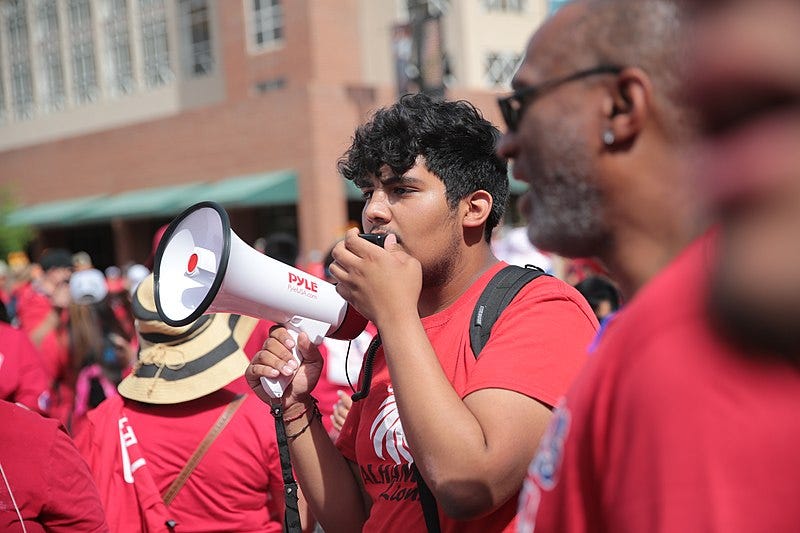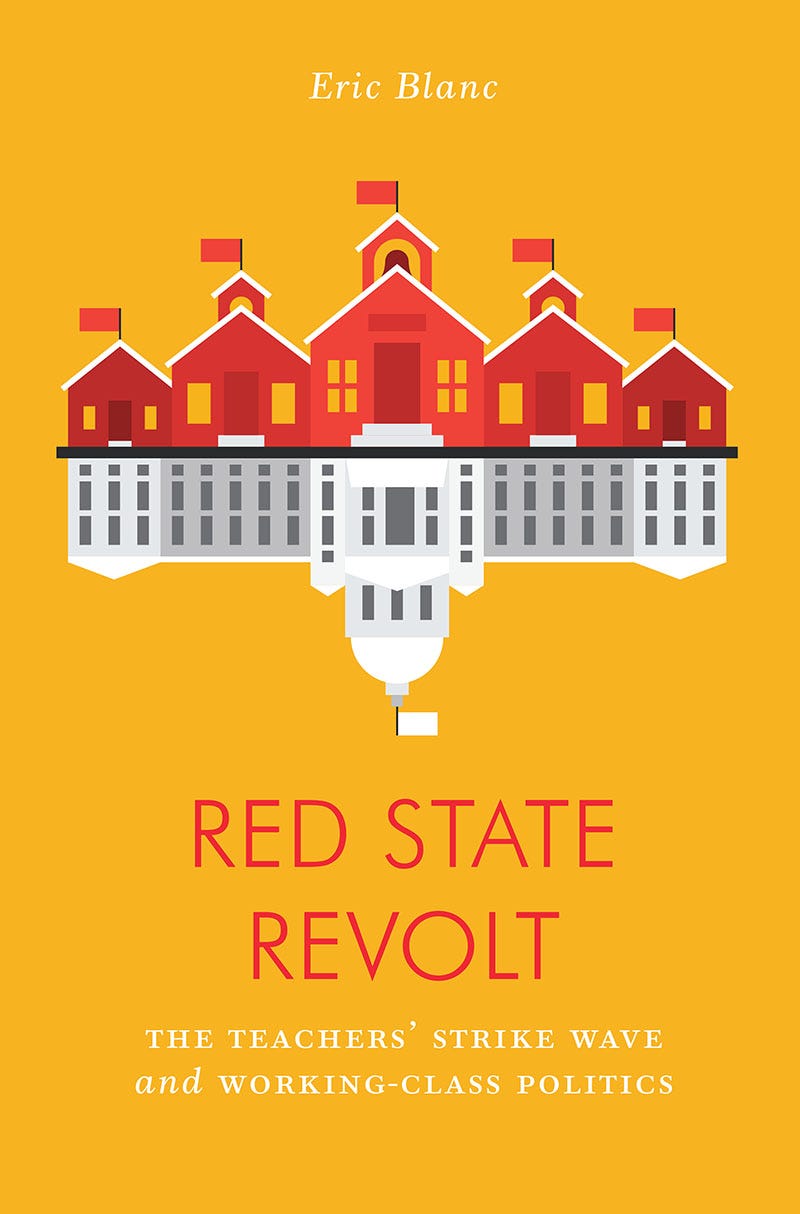How teachers can win
A review of Eric Blanc’s “Red State Revolt: The Teachers’ Strike Wave and Working-Class Politics”

If there is one thing I learned in high school, it’s not to trifle with teachers when they set a due date.
South Carolina’s activist teacher network SC for Ed has set a hard deadline of March 17 for the state legislature to take action on an 8-point legislative agenda.
“We wish to work with our political leaders to make this goal a reality,” the group said on Twitter in November. “However, we must stress that failure to achieve this goal by March 17, 2020 will leave our members no choice but to respond accordingly to the failures of our government to offer education an honorable deal.”


This is the same group that organized a 10,000-person march to the Statehouse on a school day on May 1, 2019. For the first time in a generation, my state’s public school teachers are flexing their activist muscles for livable wages, employment protections, and better learning conditions for students. And for the first time in my memory, the people who control the state’s budget are starting to listen.
In my time covering education as a newspaper reporter, it was tempting to compare and contrast South Carolina’s teacher movement to North Carolina’s, which held a similar May 1 rally in 2018 and 2019. It’s also easy enough to lump South Carolina in with West Virginia, Arizona, and Oklahoma — Republican-controlled states that saw larger and more protracted teacher uprisings in 2018.
Seeking insights and points of comparison, I picked up a copy of Eric Blanc’s Red State Revolt: The Teachers’ Strike Wave and Working-Class Politics (Verso, 2019), an on-the-ground history of the three unlikely teacher strikes of 2018. A major takeaway was that each strike was different in important ways. While teachers drew inspiration from their colleagues across the country, in Los Angeles, and in Chicago, the lay of the land was different in each case — from Koch-backed red-baiting in Arizona to the anti-tax lobbying of fossil fuel interests in West Virginia.
Union organizer Jane McAlevey, quoted in Blanc’s book, pushed back against the terminology of a multi-state “strike wave.”
“A wave sounds like a mysterious phenomenon that we don’t have any control over,” McAlevey said. “It implies that the wave can suddenly go back out to sea, regardless of what we do. I don’t believe that. I believe that it’s up to us to figure out how to continue building powerful movements right now.”
Blanc believes an important factor in the 2018 teacher movement was the presence of a “militant minority” of educator-activists, whom he defines as “individuals with a class struggle orientation, significant organizing experience, and a willingness to act independently of (and, if necessary, against) the top union officialdom.”
He makes the case that the qualitative leadership skills of a handful of organizers may have tipped the scales to make Arizona and West Virginia’s strikes more effective than Oklahoma’s, where he saw an “absence of a layer of militant teacher organizers.”
Other reviewers have criticized Blanc for overselling the influence of a handful of socialists and Bernie Sanders supporters in the teacher movement. I’m not in a position to pass judgment on the matter; I was not on the ground interviewing teachers in other states.
I will say that, at least in South Carolina in 2019, party and national politics came up as an afterthought if they came up at all. I saw a Sanders campaign booth on the Statehouse grounds during the protest, but the campaign was there to court voters and volunteers, not to foment or organize. Kamala Harris, Joe Biden, Cory Booker, and Beto O’Rourke also offered support and encouragement, but not until the teachers themselves had been organizing for months.
I highly recommend Blanc’s book to anyone looking to build a movement for public education at the state level. With the caveat that some conditions are unique in each state, here are a few of the broader takeaways that I think could apply in South Carolina or elsewhere:
Stand with students.
From school board meetings to Statehouse hearings, I’ve heard Republicans tout private school vouchers and punitive teacher evaluations as “student-first” policies. The implication is that the needs of public school teachers and public school students are somehow at odds.
Any successful teacher movement will have to break that narrative.
During each of the 2018 teacher strikes, Blanc noted that high school students organized rallies in solidarity with their teachers (p. 78):
To win parent and student support, teachers in West Virginia, like Arizona, began grassroots organizing months before they voted to go on strike. They took every opportunity for discussion with parents, explaining that educator working conditions were students’ learning conditions …
Fighting for students, and framing their struggles as a defense of essential services for the public, went a long way toward undercutting the Right’s constant harping that striking teachers were hurting children.
I saw this on a limited level in South Carolina’s 2019 walkout, where activist students including a vocal group of teacher cadets from Summerville made the trip to march in Columbia. Standing shoulder to shoulder with their teachers, they offered a powerful rebuke to state officials’ narrative of teachers “abandoning” their students.

Meet in person.
A common media narrative during the West Virginia strike was that teachers used private Facebook groups to organize mass actions independently of the more cautious union establishment. The grassroots began online and eventually forced wary union bosses to capitulate.
It is true that social media provided a new tool for subverting the top-down approach of the union establishment in that state. But Blanc contends that the “Facebook activism” narrative may have been a bit overplayed (p. 116):
… the ease of mobilization and communication provided by Facebook has real downsides. In the Internet age, mass protests can scale up very quickly — sometimes too quickly for powerful organizations to develop in the process. Without the political relationships and infrastructure forged through in-person organizing, protest movements that rely on social media can be structurally fragile and ill-equipped to confront either harsh ruling-class opposition or serious internal debates.
Oklahoma’s teacher movement provides a cautionary tale here. As Blanc details in the book, rival Facebook groups sprang up with different agendas and loose moderation. In the end, the lack of a unified front shortened the strike’s duration and weakened the movement’s effectiveness.
Broaden the base.
One key to West Virginia teachers’ success was uniting all 55 counties and shutting down every school during the strike. It was a monumental undertaking, and it got results.
While the workers’ movements in the three states were commonly referred to as teacher strikes, they included all types of school employees, including bus drivers, custodians, cafeteria workers, and secretaries. West Virginia’s strike focused much of its energy on fixing the funding for the state’s Public Employee Insurance Agency, which applies to public servants beyond school walls.
Building that broad base took months of solidarity-building, organizing, and patient conversation. Beyond the material gains of the strike, the teachers were expanding people’s political imagination. Blanc quotes Abby Broome, a teacher in Putnam County, West Virginia, who recalled walking near the state capitol in her red strike bandana and hearing words of encouragement from homeless people at a bus stop:
“I was tired like everyone else. I wanted things to get back to normal,” she said (p. 2). “But I felt energized and respected like I never had. I was proud. We were doing something bigger than ourselves. I think we were giving other people a little hope.”
Identify your enemies.
Last year, Kentucky teachers flexed their political muscles and received a good deal of credit for ousting Republican Gov. Matt Bevin, who had provoked and opposed them during walkouts. This adversarial relationship to power echoes some of the greatest successes from West Virginia, Arizona, and Oklahoma.
West Virginia teachers chanted “Tax our gas” and clashed openly with their billionaire coal-heir governor. Arizona teachers called their governor to the mat in interviews with national press. And as in Kentucky, Oklahoma teachers played a key role in purging their enemies from office in the subsequent state legislative election.


Prepare for red-baiting.
Deep in the heart of Koch Brothers country, Arizona teachers had to contend with old-fashioned McCarthyite tactics. Gov. Doug Ducey refused to meet with Red for Ed leaders, claiming that the public school teachers were “political operatives.”
In one of the lowest blows of the year, the state GOP chair sent out an email accusing Red for Ed of “sinister motives” and specifically citing a Breitbart News piece on 24-year-old Tres Rios Elementary School music teacher Noah Karvelis.
Karvelis, 24, found himself under the microscope of a powerful and well-funded right-wing apparatus. Arizona House Rep. Maria Syms wrote in an Arizona Republic op-ed:
If [Karvelis] gets [his goal], we will see contemporary radical politics at its treacherous worst, where harm to our children and their academic achievement are necessary collateral damage in the cause of leftist revolution. Arizonans should take a stand against such threats to our children and our democracy.
Red for Ed leaders stood with Karvelis but noted that he never claimed to speak for the politics of the whole group. Karvelis, for his part, sought to steer every interview toward the broader cause of public educators across the political spectrum.
“It’s the hardest thing to stand up and know that you’ll be smeared,” Karvelis told Blanc in an interview after the strike. “But if you don’t do it, who will?” (p. 179)
***
Red State Revolt is available for $13.96 via Verso Books.
The image at the top was taken by Gage Skidmore at an Arizona teachers’ rally on April 26, 2018. It was uploaded with a Creative Commons Attribution 2.0 Generic license by the Arizona Education Association.
In case you missed it, I had a few wildly unrelated pieces published in other outlets during the holiday season. The Charleston City Paper included my experimental short story “Life Alert” in their annual Lit Issue, and Thrillist published my interview with a teenager who organized a punk show in a Denny’s.


